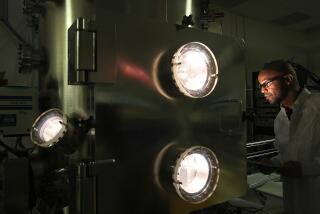Shuttle’s Loss Hits at Heart of Downey
- Share via
The Downey warehouses where an army of scientists created America’s space shuttle fleet will soon be gone. But the shuttle Columbia and its crew of seven will not be forgotten.
An interactive learning center will be built to honor Downey’s contributions to both the Apollo and the space shuttle programs. “We were going to have a Challenger memorial” at the learning center, said Mayor Pro Tem Kirk Cartozian. “Now we’ll have one for Columbia too.”
The suburban city with deep aerospace roots is still grappling with Saturday’s tragedy and moving quickly to commemorate Columbia’s legacy.
Officials are scrambling to put up a Columbia memorial at City Hall. Downey High students are being encouraged to write letters to the families of the seven astronauts who died Saturday when Columbia broke up over Texas. And Cartozian, a history teacher, will devote classes today at Downey High School to Columbia.
“We had a historical part in Columbia and space history,” said the 29-year-old lifetime Downey resident. “This is a way we can tie students into education and history.”
In its heyday, more than 30,000 people worked at what NASA has referred to as “the cradle,” the Rockwell International Corp. factory. The 160-acre facility sits behind high fences between Lakewood and Bellflower boulevards and between Imperial Highway and Stewart and Gray Road.
The engineers, technicians and other workers were brought together by North American Aviation for the Apollo project. In 1972, then working for Rockwell International Corp., they began developing the space shuttle. After they designed and manufactured shuttle components, the parts were sent to Palmdale for assembly.
“What we were doing had never been conceived of,” said Jerry Blackburn, a retired engineer. “There was no book you could go pull off a shelf that could tell you how to do that.”
The Columbia was delivered to NASA in 1979. Rockwell was also the prime contractor in producing the shuttles Challenger, Discovery, Atlantis and Endeavour. Today, the NASA Industrial Plant sits idle, waiting for construction to begin on a $650-million development called Downey Landing.
When completed, officials said, the site will include a shopping center, a 381-bed Kaiser Permanente hospital, a park, a film production center and a business complex. It will also be home to the space science learning center.
“The community’s ego was really hurt with the closure” of the NASA Industrial Plant, Downey City Manager Gerald Caton said. The city’s “claim to fame was ... being a NASA city.”
He said the redevelopment project will help restore that prestige, recoup jobs and $600,000 in annual tax revenue lost when Boeing, which bought most of Rockwell’s space and defense operations in 1996, closed the plant and relocated to Huntington Beach four years ago. Nearly 3,000 workers went with it.
Constructing a $550-million Kaiser hospital on 30 acres of the site should remedy that, Caton said. “Kaiser will bring about 3,000 jobs, making it the city’s largest employer,” he said.
Downey’s space era began soon after President John F. Kennedy established a U.S. goal to put a man on the moon before the end of the decade. In 1961, NASA contracted with North American to design a command and service module for Apollo, a spacecraft vehicle to carry three men to the moon and bring them safely home.
After Neil Armstrong and Buzz Aldrin triumphantly walked on the moon in 1969, they returned to the Downey plant to thank the Apollo visionaries and workers there.
During the space shuttle era, President Reagan visited the site in 1982 to salute the workers a year after Columbia’s maiden flight. James Busby, a historian with Downey’s Aerospace Legacy Foundation, gave tours during that time and did so until 1999 when the plant closed.
He recalled on Tuesday watching Columbia’s cockpit being constructed. So for him, watching the loss of the Columbia on TV was “a terrible emotional drain,” he said. “It’s like someone cut your heart out, put it in front of you, and made you look at it.”
More to Read
Inside the business of entertainment
The Wide Shot brings you news, analysis and insights on everything from streaming wars to production — and what it all means for the future.
You may occasionally receive promotional content from the Los Angeles Times.










